Critical Appraisal of a Randomized Controlled Trial in Diabetes Care
VerifiedAdded on 2022/11/01
|7
|2047
|392
Report
AI Summary
This report critically appraises a randomized controlled trial (RCT) titled 'Web-based telemedicine for management of type 2 diabetes through glucose uploads: a randomized controlled trial' (Zhou et al., 2014). The appraisal utilizes the Joanna Briggs Institute (JBI) critical appraisal tool to evaluate the study's methodology, including randomization, allocation concealment, blinding, and treatment group similarity. The report highlights the strengths of the study, such as the use of true randomization and similar baseline characteristics between the treatment groups. It also identifies weaknesses, including the lack of clear information on allocation concealment and the non-blinding of participants. The report assesses the comparability of treatment groups, the completeness of follow-up, and the appropriateness of outcome measurements and statistical analyses. The study's design and the use of appropriate statistical tools are recognized as strengths. The report concludes with an overall assessment of the study's quality, importance of results, and potential for local application.
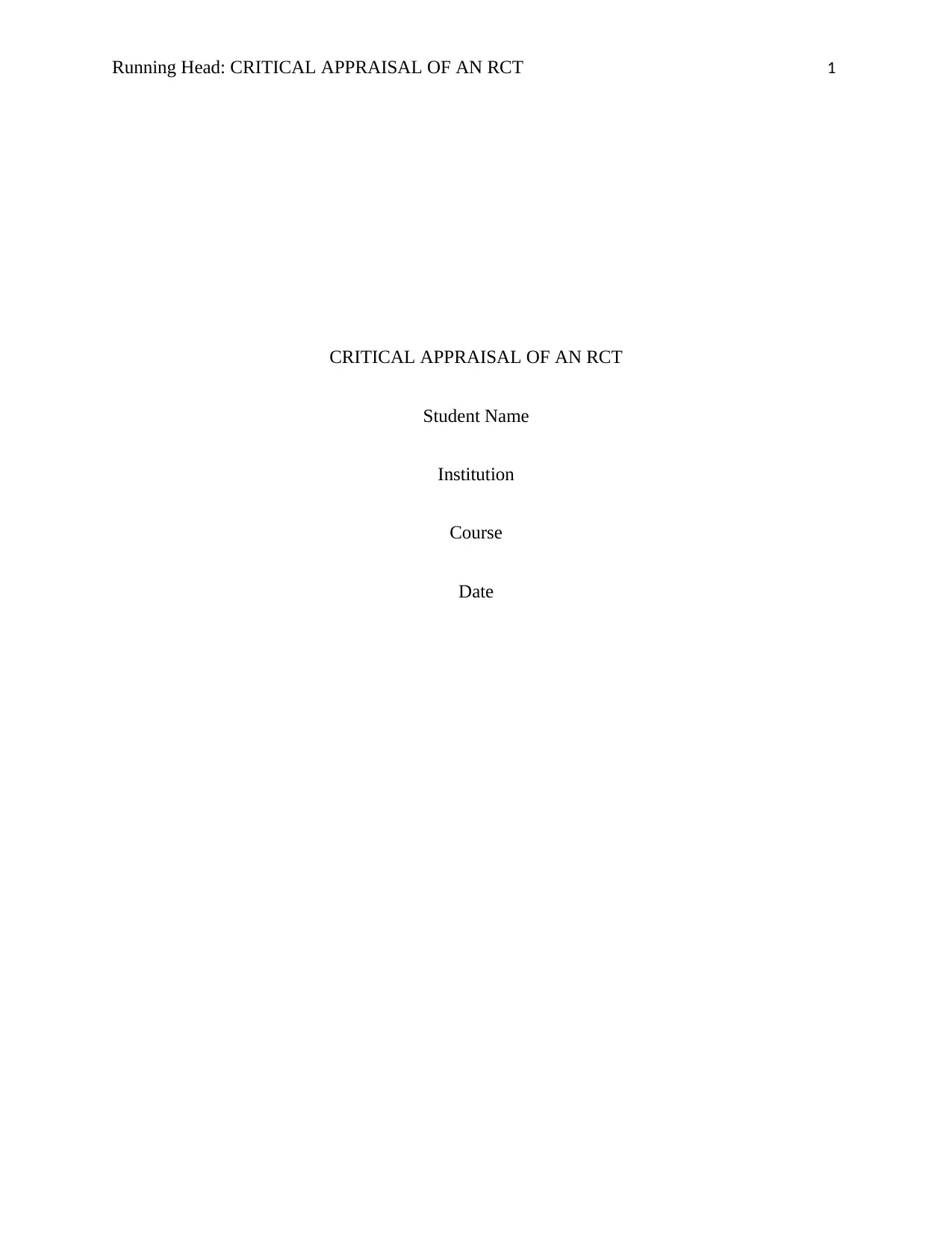
Running Head: CRITICAL APPRAISAL OF AN RCT 1
CRITICAL APPRAISAL OF AN RCT
Student Name
Institution
Course
Date
CRITICAL APPRAISAL OF AN RCT
Student Name
Institution
Course
Date
Paraphrase This Document
Need a fresh take? Get an instant paraphrase of this document with our AI Paraphraser
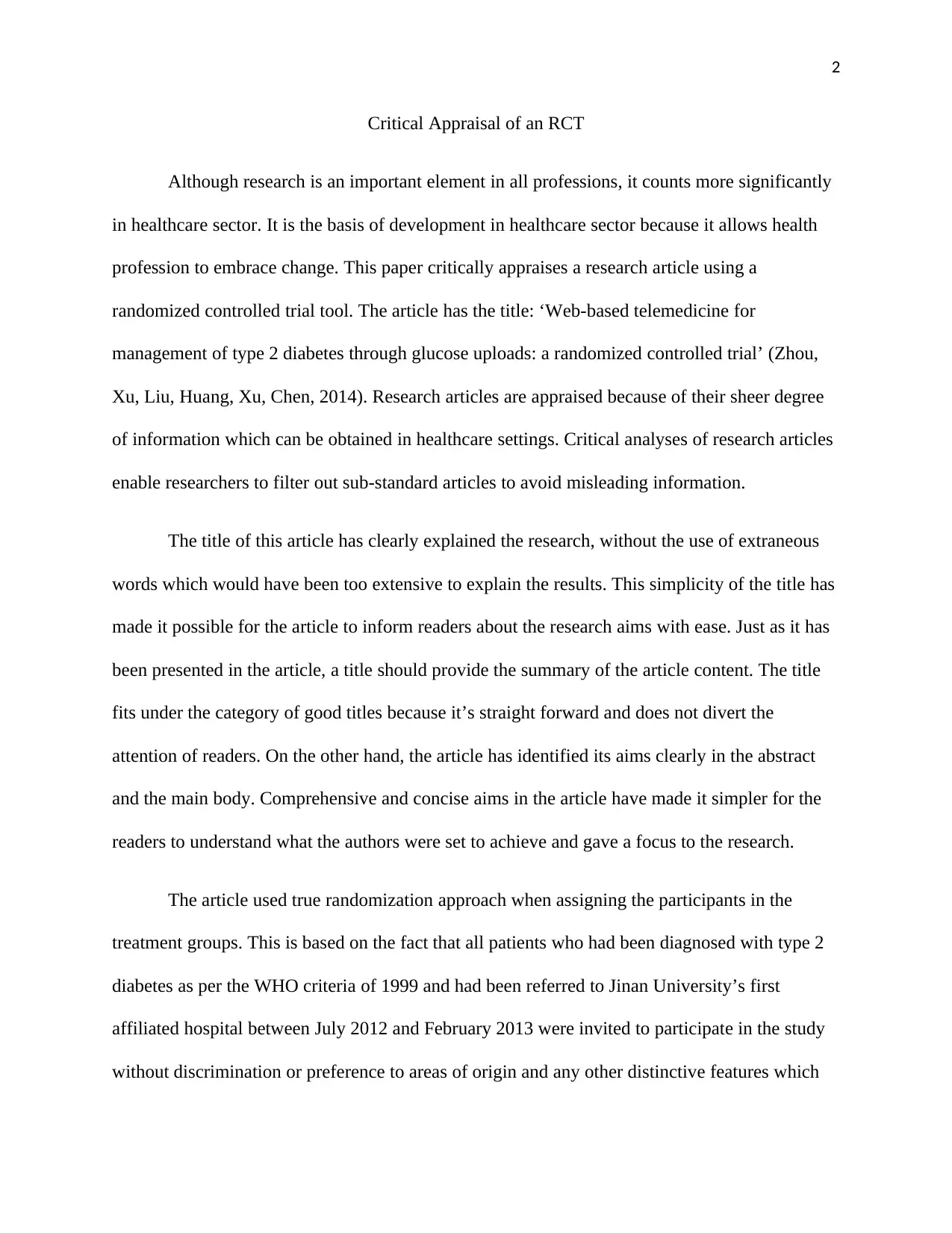
2
Critical Appraisal of an RCT
Although research is an important element in all professions, it counts more significantly
in healthcare sector. It is the basis of development in healthcare sector because it allows health
profession to embrace change. This paper critically appraises a research article using a
randomized controlled trial tool. The article has the title: ‘Web-based telemedicine for
management of type 2 diabetes through glucose uploads: a randomized controlled trial’ (Zhou,
Xu, Liu, Huang, Xu, Chen, 2014). Research articles are appraised because of their sheer degree
of information which can be obtained in healthcare settings. Critical analyses of research articles
enable researchers to filter out sub-standard articles to avoid misleading information.
The title of this article has clearly explained the research, without the use of extraneous
words which would have been too extensive to explain the results. This simplicity of the title has
made it possible for the article to inform readers about the research aims with ease. Just as it has
been presented in the article, a title should provide the summary of the article content. The title
fits under the category of good titles because it’s straight forward and does not divert the
attention of readers. On the other hand, the article has identified its aims clearly in the abstract
and the main body. Comprehensive and concise aims in the article have made it simpler for the
readers to understand what the authors were set to achieve and gave a focus to the research.
The article used true randomization approach when assigning the participants in the
treatment groups. This is based on the fact that all patients who had been diagnosed with type 2
diabetes as per the WHO criteria of 1999 and had been referred to Jinan University’s first
affiliated hospital between July 2012 and February 2013 were invited to participate in the study
without discrimination or preference to areas of origin and any other distinctive features which
Critical Appraisal of an RCT
Although research is an important element in all professions, it counts more significantly
in healthcare sector. It is the basis of development in healthcare sector because it allows health
profession to embrace change. This paper critically appraises a research article using a
randomized controlled trial tool. The article has the title: ‘Web-based telemedicine for
management of type 2 diabetes through glucose uploads: a randomized controlled trial’ (Zhou,
Xu, Liu, Huang, Xu, Chen, 2014). Research articles are appraised because of their sheer degree
of information which can be obtained in healthcare settings. Critical analyses of research articles
enable researchers to filter out sub-standard articles to avoid misleading information.
The title of this article has clearly explained the research, without the use of extraneous
words which would have been too extensive to explain the results. This simplicity of the title has
made it possible for the article to inform readers about the research aims with ease. Just as it has
been presented in the article, a title should provide the summary of the article content. The title
fits under the category of good titles because it’s straight forward and does not divert the
attention of readers. On the other hand, the article has identified its aims clearly in the abstract
and the main body. Comprehensive and concise aims in the article have made it simpler for the
readers to understand what the authors were set to achieve and gave a focus to the research.
The article used true randomization approach when assigning the participants in the
treatment groups. This is based on the fact that all patients who had been diagnosed with type 2
diabetes as per the WHO criteria of 1999 and had been referred to Jinan University’s first
affiliated hospital between July 2012 and February 2013 were invited to participate in the study
without discrimination or preference to areas of origin and any other distinctive features which
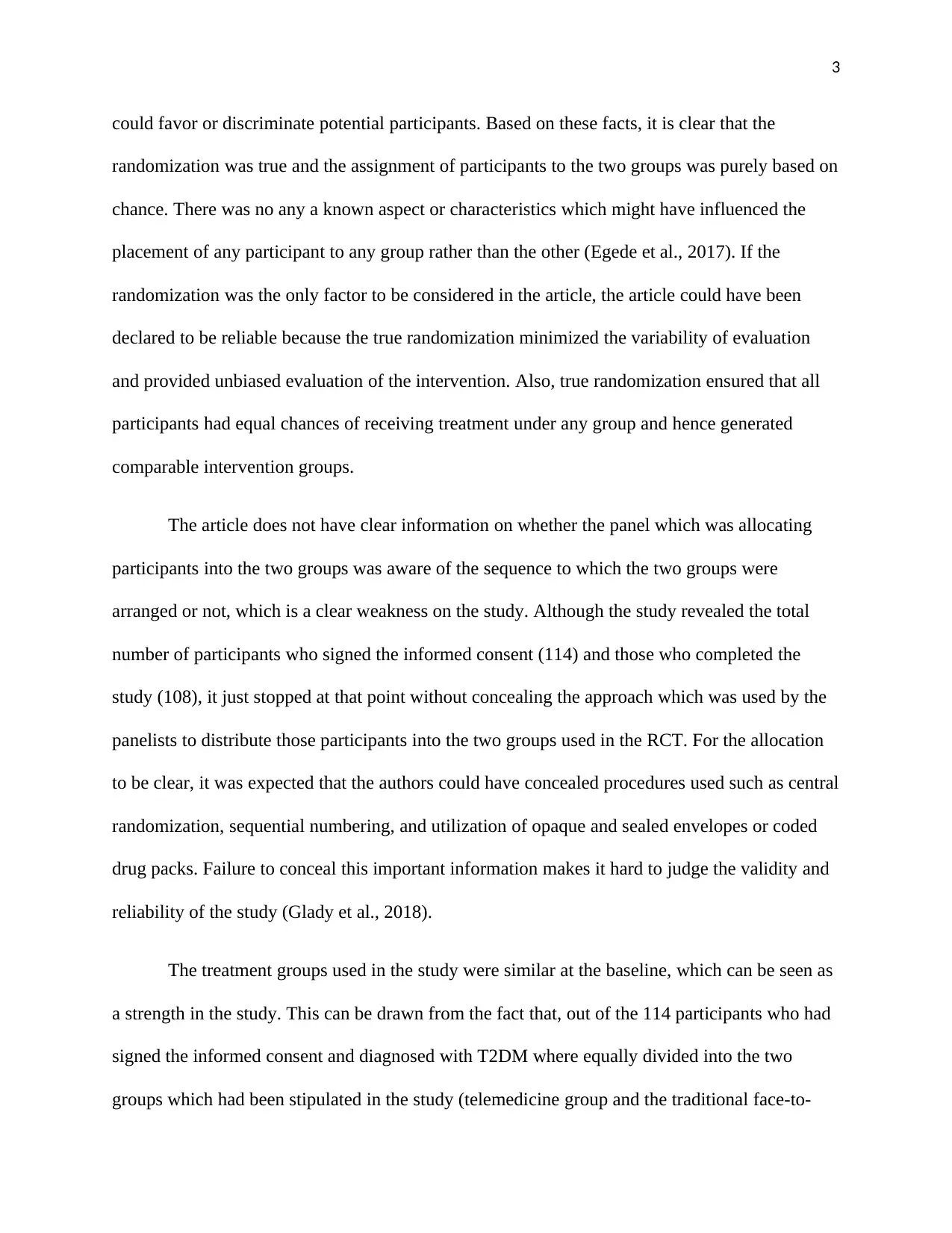
3
could favor or discriminate potential participants. Based on these facts, it is clear that the
randomization was true and the assignment of participants to the two groups was purely based on
chance. There was no any a known aspect or characteristics which might have influenced the
placement of any participant to any group rather than the other (Egede et al., 2017). If the
randomization was the only factor to be considered in the article, the article could have been
declared to be reliable because the true randomization minimized the variability of evaluation
and provided unbiased evaluation of the intervention. Also, true randomization ensured that all
participants had equal chances of receiving treatment under any group and hence generated
comparable intervention groups.
The article does not have clear information on whether the panel which was allocating
participants into the two groups was aware of the sequence to which the two groups were
arranged or not, which is a clear weakness on the study. Although the study revealed the total
number of participants who signed the informed consent (114) and those who completed the
study (108), it just stopped at that point without concealing the approach which was used by the
panelists to distribute those participants into the two groups used in the RCT. For the allocation
to be clear, it was expected that the authors could have concealed procedures used such as central
randomization, sequential numbering, and utilization of opaque and sealed envelopes or coded
drug packs. Failure to conceal this important information makes it hard to judge the validity and
reliability of the study (Glady et al., 2018).
The treatment groups used in the study were similar at the baseline, which can be seen as
a strength in the study. This can be drawn from the fact that, out of the 114 participants who had
signed the informed consent and diagnosed with T2DM where equally divided into the two
groups which had been stipulated in the study (telemedicine group and the traditional face-to-
could favor or discriminate potential participants. Based on these facts, it is clear that the
randomization was true and the assignment of participants to the two groups was purely based on
chance. There was no any a known aspect or characteristics which might have influenced the
placement of any participant to any group rather than the other (Egede et al., 2017). If the
randomization was the only factor to be considered in the article, the article could have been
declared to be reliable because the true randomization minimized the variability of evaluation
and provided unbiased evaluation of the intervention. Also, true randomization ensured that all
participants had equal chances of receiving treatment under any group and hence generated
comparable intervention groups.
The article does not have clear information on whether the panel which was allocating
participants into the two groups was aware of the sequence to which the two groups were
arranged or not, which is a clear weakness on the study. Although the study revealed the total
number of participants who signed the informed consent (114) and those who completed the
study (108), it just stopped at that point without concealing the approach which was used by the
panelists to distribute those participants into the two groups used in the RCT. For the allocation
to be clear, it was expected that the authors could have concealed procedures used such as central
randomization, sequential numbering, and utilization of opaque and sealed envelopes or coded
drug packs. Failure to conceal this important information makes it hard to judge the validity and
reliability of the study (Glady et al., 2018).
The treatment groups used in the study were similar at the baseline, which can be seen as
a strength in the study. This can be drawn from the fact that, out of the 114 participants who had
signed the informed consent and diagnosed with T2DM where equally divided into the two
groups which had been stipulated in the study (telemedicine group and the traditional face-to-
⊘ This is a preview!⊘
Do you want full access?
Subscribe today to unlock all pages.

Trusted by 1+ million students worldwide
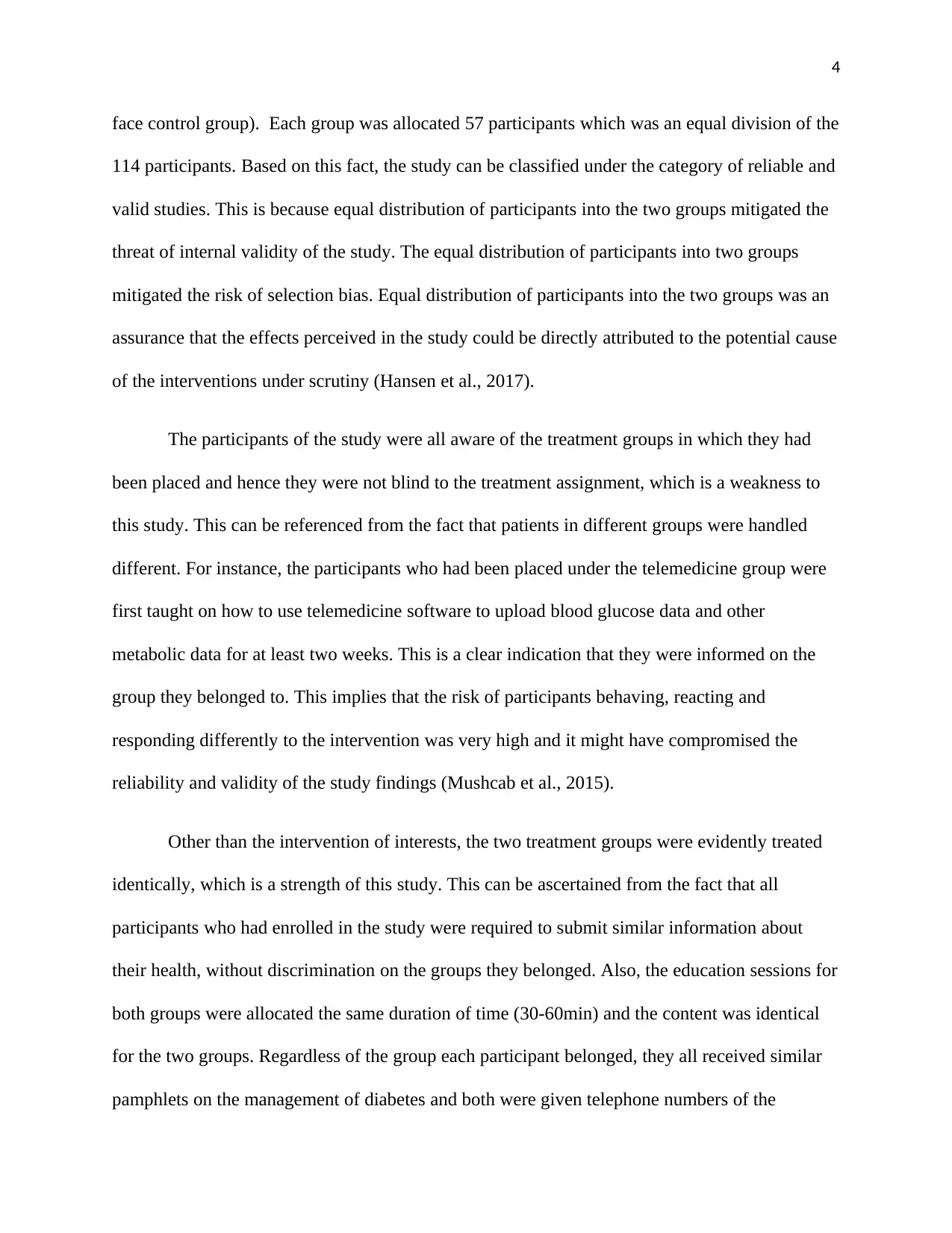
4
face control group). Each group was allocated 57 participants which was an equal division of the
114 participants. Based on this fact, the study can be classified under the category of reliable and
valid studies. This is because equal distribution of participants into the two groups mitigated the
threat of internal validity of the study. The equal distribution of participants into two groups
mitigated the risk of selection bias. Equal distribution of participants into the two groups was an
assurance that the effects perceived in the study could be directly attributed to the potential cause
of the interventions under scrutiny (Hansen et al., 2017).
The participants of the study were all aware of the treatment groups in which they had
been placed and hence they were not blind to the treatment assignment, which is a weakness to
this study. This can be referenced from the fact that patients in different groups were handled
different. For instance, the participants who had been placed under the telemedicine group were
first taught on how to use telemedicine software to upload blood glucose data and other
metabolic data for at least two weeks. This is a clear indication that they were informed on the
group they belonged to. This implies that the risk of participants behaving, reacting and
responding differently to the intervention was very high and it might have compromised the
reliability and validity of the study findings (Mushcab et al., 2015).
Other than the intervention of interests, the two treatment groups were evidently treated
identically, which is a strength of this study. This can be ascertained from the fact that all
participants who had enrolled in the study were required to submit similar information about
their health, without discrimination on the groups they belonged. Also, the education sessions for
both groups were allocated the same duration of time (30-60min) and the content was identical
for the two groups. Regardless of the group each participant belonged, they all received similar
pamphlets on the management of diabetes and both were given telephone numbers of the
face control group). Each group was allocated 57 participants which was an equal division of the
114 participants. Based on this fact, the study can be classified under the category of reliable and
valid studies. This is because equal distribution of participants into the two groups mitigated the
threat of internal validity of the study. The equal distribution of participants into two groups
mitigated the risk of selection bias. Equal distribution of participants into the two groups was an
assurance that the effects perceived in the study could be directly attributed to the potential cause
of the interventions under scrutiny (Hansen et al., 2017).
The participants of the study were all aware of the treatment groups in which they had
been placed and hence they were not blind to the treatment assignment, which is a weakness to
this study. This can be referenced from the fact that patients in different groups were handled
different. For instance, the participants who had been placed under the telemedicine group were
first taught on how to use telemedicine software to upload blood glucose data and other
metabolic data for at least two weeks. This is a clear indication that they were informed on the
group they belonged to. This implies that the risk of participants behaving, reacting and
responding differently to the intervention was very high and it might have compromised the
reliability and validity of the study findings (Mushcab et al., 2015).
Other than the intervention of interests, the two treatment groups were evidently treated
identically, which is a strength of this study. This can be ascertained from the fact that all
participants who had enrolled in the study were required to submit similar information about
their health, without discrimination on the groups they belonged. Also, the education sessions for
both groups were allocated the same duration of time (30-60min) and the content was identical
for the two groups. Regardless of the group each participant belonged, they all received similar
pamphlets on the management of diabetes and both were given telephone numbers of the
Paraphrase This Document
Need a fresh take? Get an instant paraphrase of this document with our AI Paraphraser
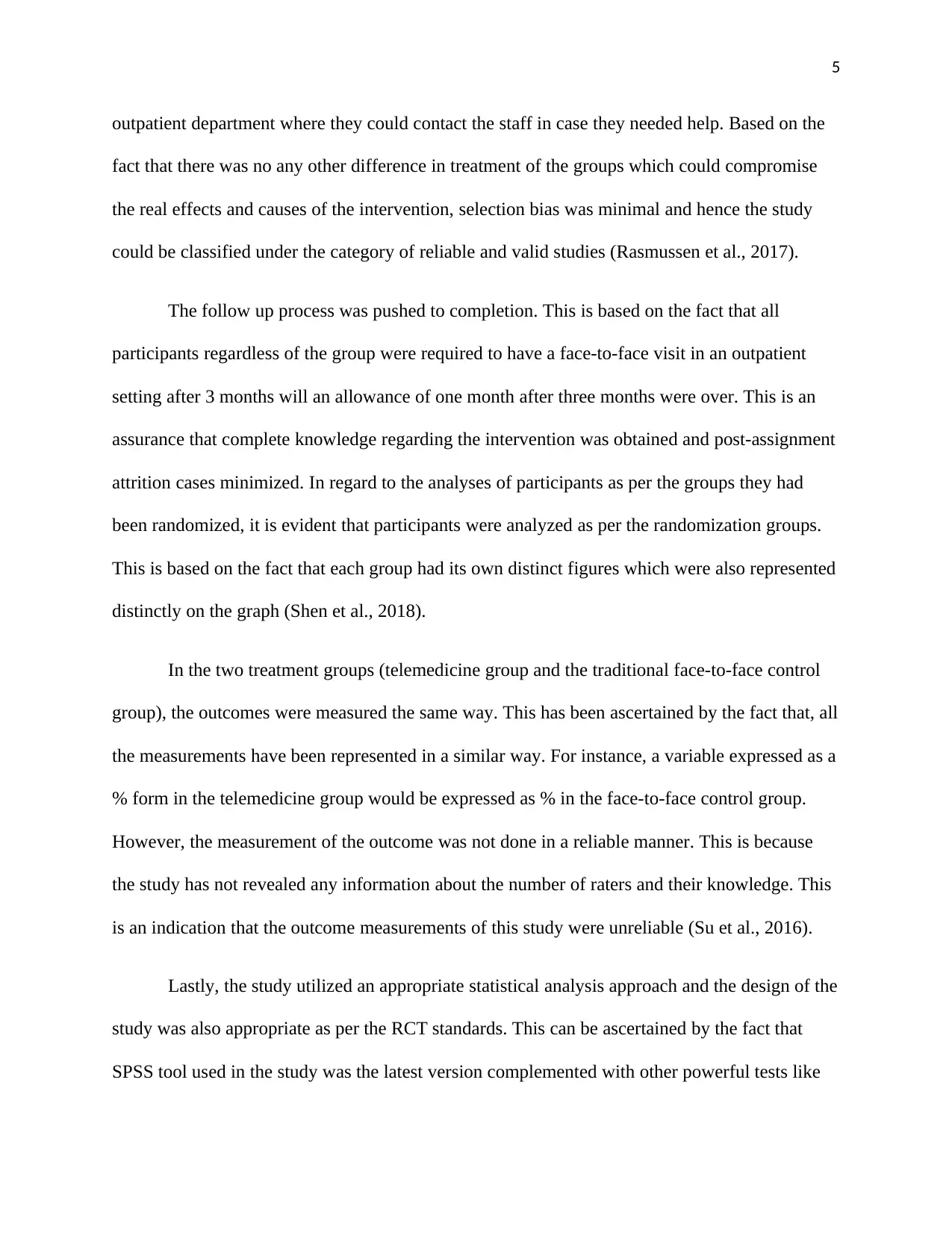
5
outpatient department where they could contact the staff in case they needed help. Based on the
fact that there was no any other difference in treatment of the groups which could compromise
the real effects and causes of the intervention, selection bias was minimal and hence the study
could be classified under the category of reliable and valid studies (Rasmussen et al., 2017).
The follow up process was pushed to completion. This is based on the fact that all
participants regardless of the group were required to have a face-to-face visit in an outpatient
setting after 3 months will an allowance of one month after three months were over. This is an
assurance that complete knowledge regarding the intervention was obtained and post-assignment
attrition cases minimized. In regard to the analyses of participants as per the groups they had
been randomized, it is evident that participants were analyzed as per the randomization groups.
This is based on the fact that each group had its own distinct figures which were also represented
distinctly on the graph (Shen et al., 2018).
In the two treatment groups (telemedicine group and the traditional face-to-face control
group), the outcomes were measured the same way. This has been ascertained by the fact that, all
the measurements have been represented in a similar way. For instance, a variable expressed as a
% form in the telemedicine group would be expressed as % in the face-to-face control group.
However, the measurement of the outcome was not done in a reliable manner. This is because
the study has not revealed any information about the number of raters and their knowledge. This
is an indication that the outcome measurements of this study were unreliable (Su et al., 2016).
Lastly, the study utilized an appropriate statistical analysis approach and the design of the
study was also appropriate as per the RCT standards. This can be ascertained by the fact that
SPSS tool used in the study was the latest version complemented with other powerful tests like
outpatient department where they could contact the staff in case they needed help. Based on the
fact that there was no any other difference in treatment of the groups which could compromise
the real effects and causes of the intervention, selection bias was minimal and hence the study
could be classified under the category of reliable and valid studies (Rasmussen et al., 2017).
The follow up process was pushed to completion. This is based on the fact that all
participants regardless of the group were required to have a face-to-face visit in an outpatient
setting after 3 months will an allowance of one month after three months were over. This is an
assurance that complete knowledge regarding the intervention was obtained and post-assignment
attrition cases minimized. In regard to the analyses of participants as per the groups they had
been randomized, it is evident that participants were analyzed as per the randomization groups.
This is based on the fact that each group had its own distinct figures which were also represented
distinctly on the graph (Shen et al., 2018).
In the two treatment groups (telemedicine group and the traditional face-to-face control
group), the outcomes were measured the same way. This has been ascertained by the fact that, all
the measurements have been represented in a similar way. For instance, a variable expressed as a
% form in the telemedicine group would be expressed as % in the face-to-face control group.
However, the measurement of the outcome was not done in a reliable manner. This is because
the study has not revealed any information about the number of raters and their knowledge. This
is an indication that the outcome measurements of this study were unreliable (Su et al., 2016).
Lastly, the study utilized an appropriate statistical analysis approach and the design of the
study was also appropriate as per the RCT standards. This can be ascertained by the fact that
SPSS tool used in the study was the latest version complemented with other powerful tests like
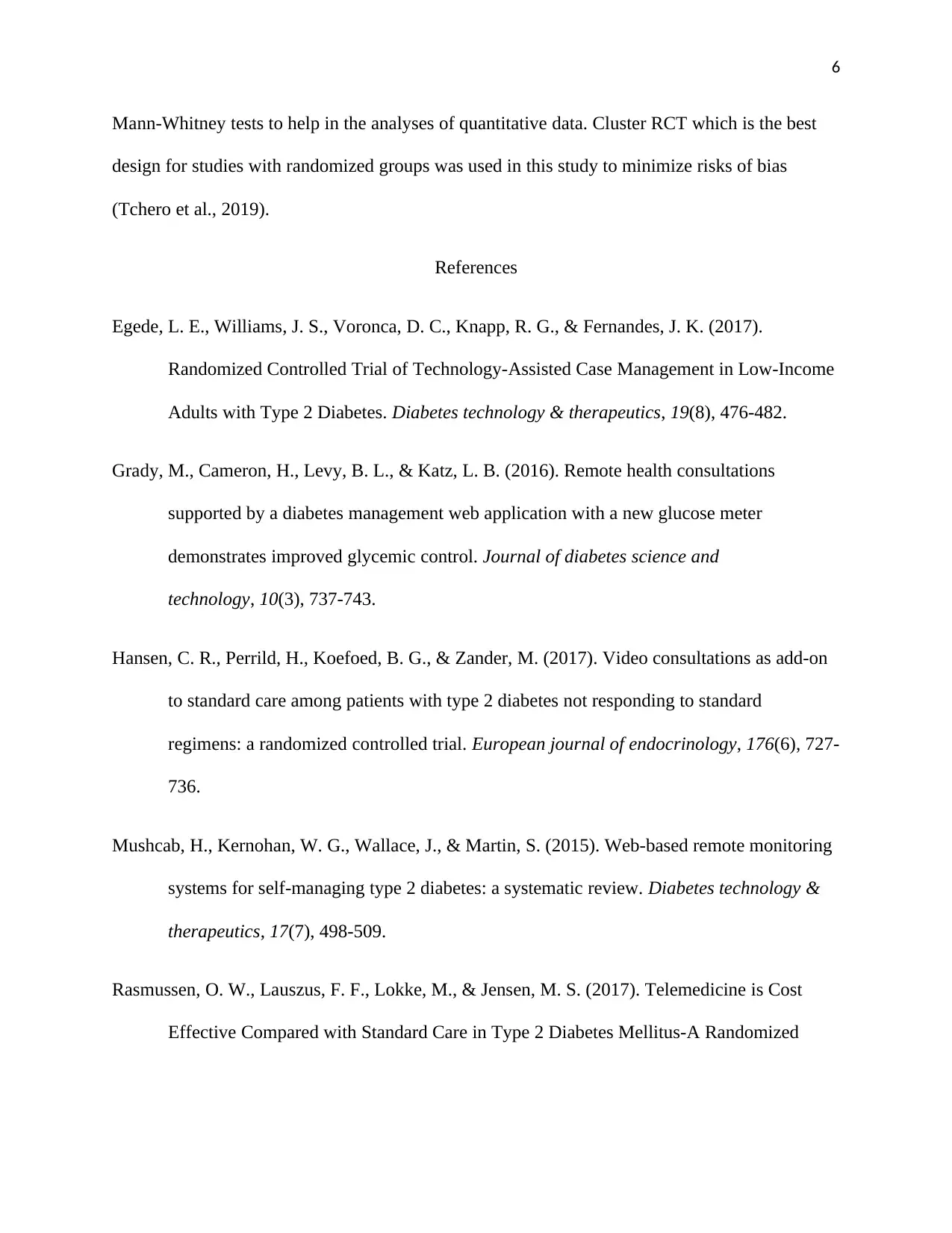
6
Mann-Whitney tests to help in the analyses of quantitative data. Cluster RCT which is the best
design for studies with randomized groups was used in this study to minimize risks of bias
(Tchero et al., 2019).
References
Egede, L. E., Williams, J. S., Voronca, D. C., Knapp, R. G., & Fernandes, J. K. (2017).
Randomized Controlled Trial of Technology-Assisted Case Management in Low-Income
Adults with Type 2 Diabetes. Diabetes technology & therapeutics, 19(8), 476-482.
Grady, M., Cameron, H., Levy, B. L., & Katz, L. B. (2016). Remote health consultations
supported by a diabetes management web application with a new glucose meter
demonstrates improved glycemic control. Journal of diabetes science and
technology, 10(3), 737-743.
Hansen, C. R., Perrild, H., Koefoed, B. G., & Zander, M. (2017). Video consultations as add-on
to standard care among patients with type 2 diabetes not responding to standard
regimens: a randomized controlled trial. European journal of endocrinology, 176(6), 727-
736.
Mushcab, H., Kernohan, W. G., Wallace, J., & Martin, S. (2015). Web-based remote monitoring
systems for self-managing type 2 diabetes: a systematic review. Diabetes technology &
therapeutics, 17(7), 498-509.
Rasmussen, O. W., Lauszus, F. F., Lokke, M., & Jensen, M. S. (2017). Telemedicine is Cost
Effective Compared with Standard Care in Type 2 Diabetes Mellitus-A Randomized
Mann-Whitney tests to help in the analyses of quantitative data. Cluster RCT which is the best
design for studies with randomized groups was used in this study to minimize risks of bias
(Tchero et al., 2019).
References
Egede, L. E., Williams, J. S., Voronca, D. C., Knapp, R. G., & Fernandes, J. K. (2017).
Randomized Controlled Trial of Technology-Assisted Case Management in Low-Income
Adults with Type 2 Diabetes. Diabetes technology & therapeutics, 19(8), 476-482.
Grady, M., Cameron, H., Levy, B. L., & Katz, L. B. (2016). Remote health consultations
supported by a diabetes management web application with a new glucose meter
demonstrates improved glycemic control. Journal of diabetes science and
technology, 10(3), 737-743.
Hansen, C. R., Perrild, H., Koefoed, B. G., & Zander, M. (2017). Video consultations as add-on
to standard care among patients with type 2 diabetes not responding to standard
regimens: a randomized controlled trial. European journal of endocrinology, 176(6), 727-
736.
Mushcab, H., Kernohan, W. G., Wallace, J., & Martin, S. (2015). Web-based remote monitoring
systems for self-managing type 2 diabetes: a systematic review. Diabetes technology &
therapeutics, 17(7), 498-509.
Rasmussen, O. W., Lauszus, F. F., Lokke, M., & Jensen, M. S. (2017). Telemedicine is Cost
Effective Compared with Standard Care in Type 2 Diabetes Mellitus-A Randomized
⊘ This is a preview!⊘
Do you want full access?
Subscribe today to unlock all pages.

Trusted by 1+ million students worldwide
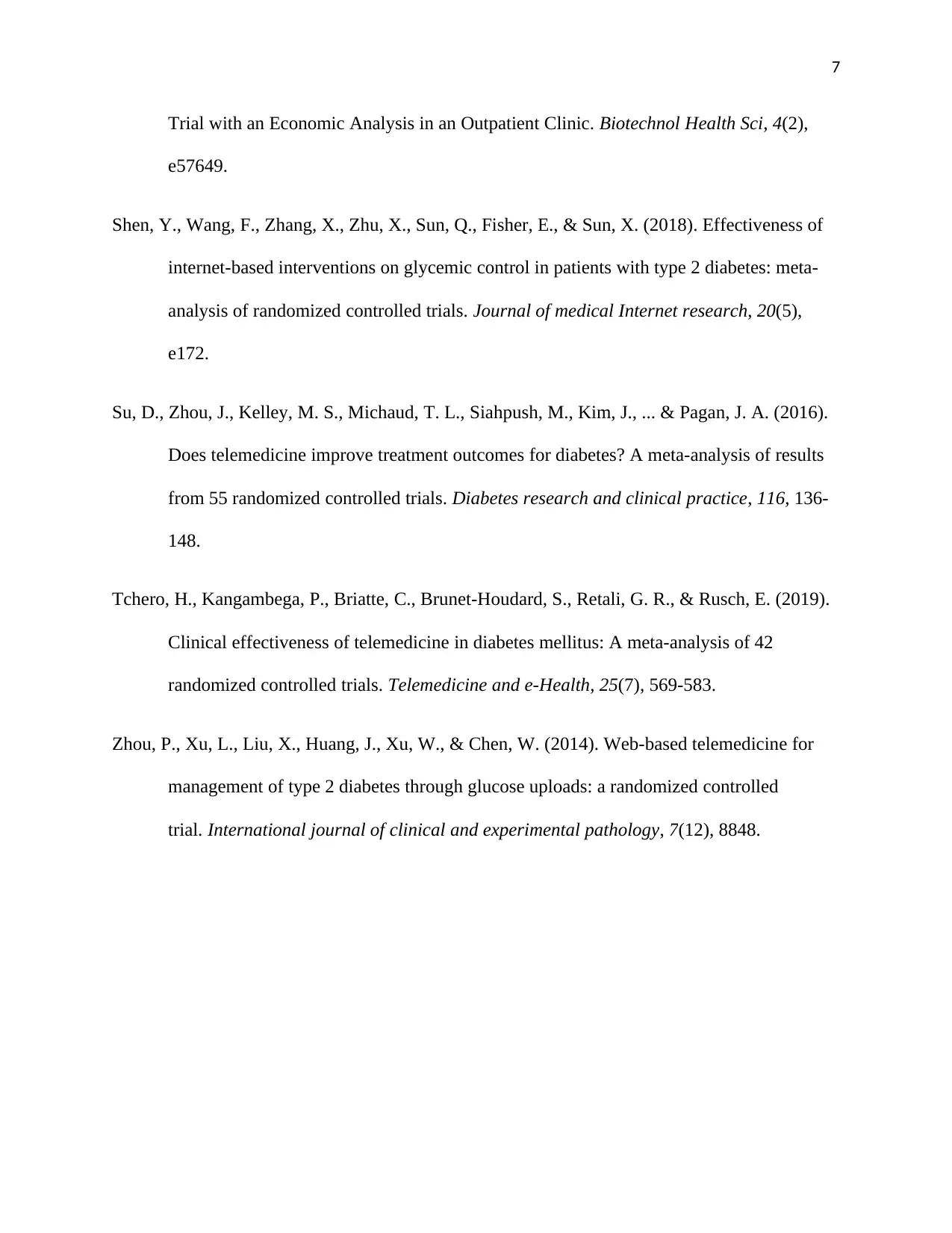
7
Trial with an Economic Analysis in an Outpatient Clinic. Biotechnol Health Sci, 4(2),
e57649.
Shen, Y., Wang, F., Zhang, X., Zhu, X., Sun, Q., Fisher, E., & Sun, X. (2018). Effectiveness of
internet-based interventions on glycemic control in patients with type 2 diabetes: meta-
analysis of randomized controlled trials. Journal of medical Internet research, 20(5),
e172.
Su, D., Zhou, J., Kelley, M. S., Michaud, T. L., Siahpush, M., Kim, J., ... & Pagan, J. A. (2016).
Does telemedicine improve treatment outcomes for diabetes? A meta-analysis of results
from 55 randomized controlled trials. Diabetes research and clinical practice, 116, 136-
148.
Tchero, H., Kangambega, P., Briatte, C., Brunet-Houdard, S., Retali, G. R., & Rusch, E. (2019).
Clinical effectiveness of telemedicine in diabetes mellitus: A meta-analysis of 42
randomized controlled trials. Telemedicine and e-Health, 25(7), 569-583.
Zhou, P., Xu, L., Liu, X., Huang, J., Xu, W., & Chen, W. (2014). Web-based telemedicine for
management of type 2 diabetes through glucose uploads: a randomized controlled
trial. International journal of clinical and experimental pathology, 7(12), 8848.
Trial with an Economic Analysis in an Outpatient Clinic. Biotechnol Health Sci, 4(2),
e57649.
Shen, Y., Wang, F., Zhang, X., Zhu, X., Sun, Q., Fisher, E., & Sun, X. (2018). Effectiveness of
internet-based interventions on glycemic control in patients with type 2 diabetes: meta-
analysis of randomized controlled trials. Journal of medical Internet research, 20(5),
e172.
Su, D., Zhou, J., Kelley, M. S., Michaud, T. L., Siahpush, M., Kim, J., ... & Pagan, J. A. (2016).
Does telemedicine improve treatment outcomes for diabetes? A meta-analysis of results
from 55 randomized controlled trials. Diabetes research and clinical practice, 116, 136-
148.
Tchero, H., Kangambega, P., Briatte, C., Brunet-Houdard, S., Retali, G. R., & Rusch, E. (2019).
Clinical effectiveness of telemedicine in diabetes mellitus: A meta-analysis of 42
randomized controlled trials. Telemedicine and e-Health, 25(7), 569-583.
Zhou, P., Xu, L., Liu, X., Huang, J., Xu, W., & Chen, W. (2014). Web-based telemedicine for
management of type 2 diabetes through glucose uploads: a randomized controlled
trial. International journal of clinical and experimental pathology, 7(12), 8848.
1 out of 7
Related Documents
Your All-in-One AI-Powered Toolkit for Academic Success.
+13062052269
info@desklib.com
Available 24*7 on WhatsApp / Email
![[object Object]](/_next/static/media/star-bottom.7253800d.svg)
Unlock your academic potential
Copyright © 2020–2025 A2Z Services. All Rights Reserved. Developed and managed by ZUCOL.





